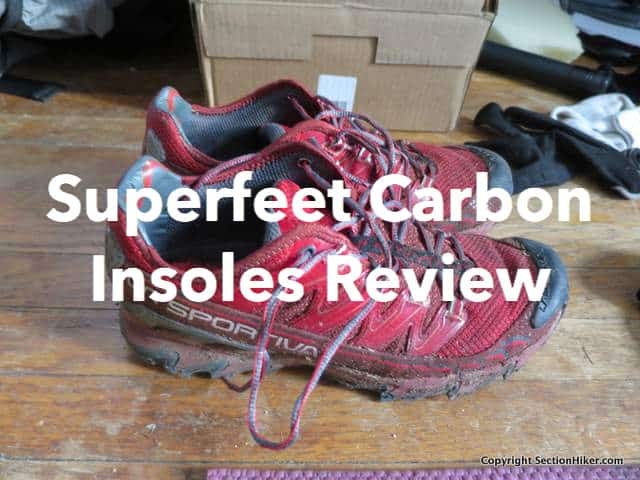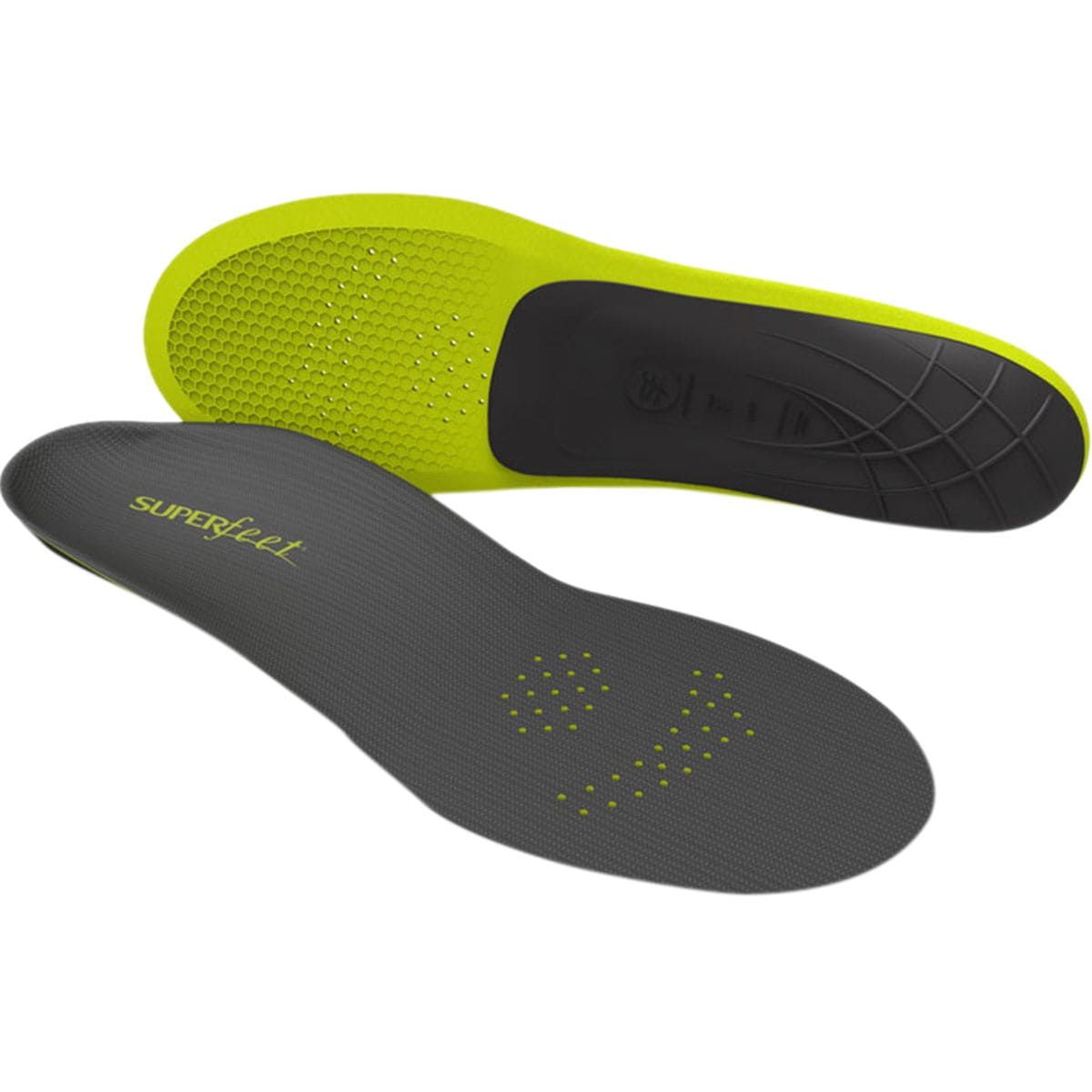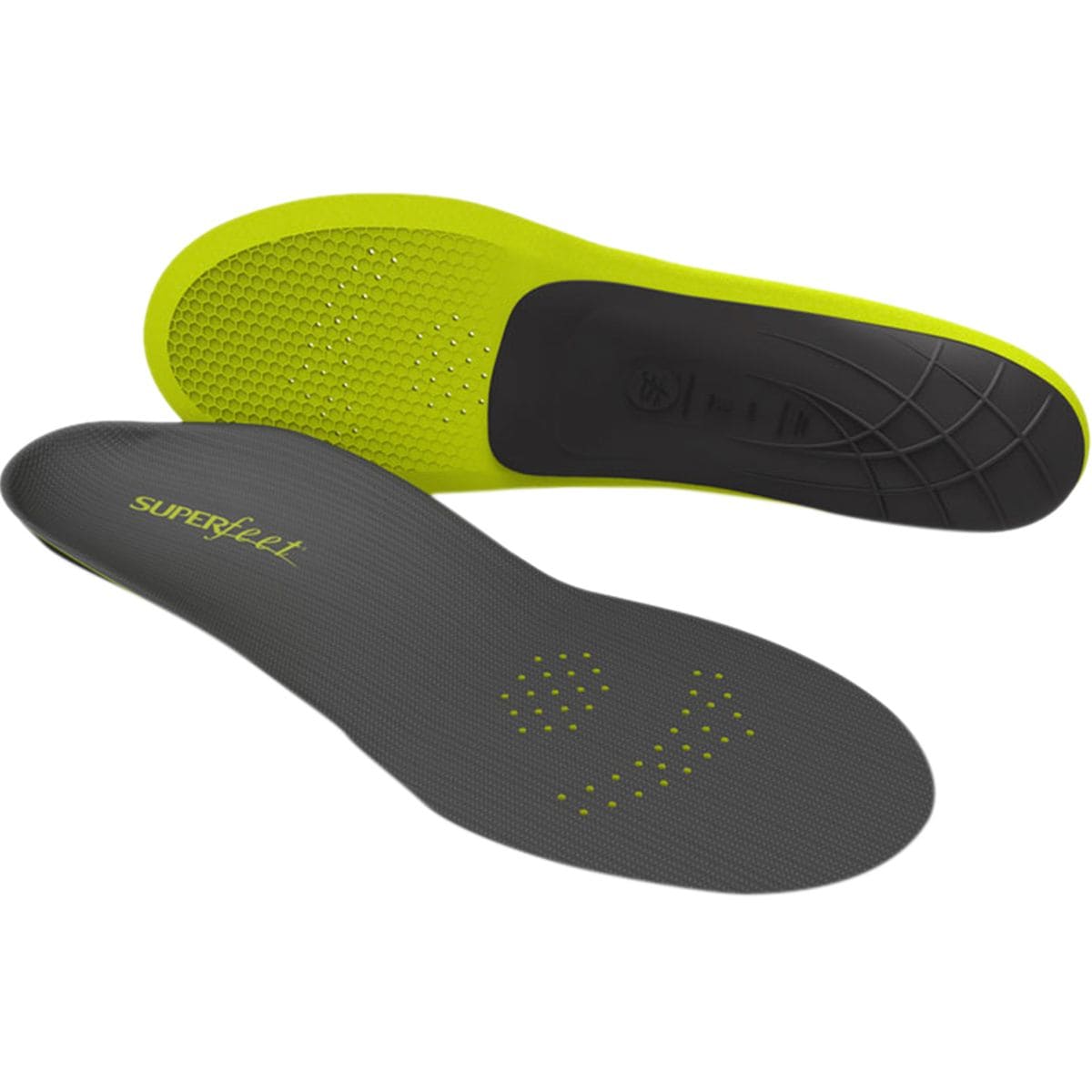 I’ve developed a case of Plantar Fasciitis in my left foot this summer, a painful repetition injury often caused by hiking or running that presents itself as chronic heel pain. The pain is caused by the inflammation of the ligament that connects your heel bone to the ball of your foot.
I’ve developed a case of Plantar Fasciitis in my left foot this summer, a painful repetition injury often caused by hiking or running that presents itself as chronic heel pain. The pain is caused by the inflammation of the ligament that connects your heel bone to the ball of your foot.
I’ve had Plantar Fasciitis before, about 9 years ago, and found that switching to a firmer insole, Superfeet Green, helped relieve the pain. But Superfeet Green are designed for use in higher volume shoes like my old leather hiking boots and not low volume trail runners like the La Sportiva Ultra Raptors that I’ve worn for hiking and backpacking the past few years.
I’ve tried other insoles since switching to trail runners, but I’ve found it difficult to find any that are thin enough to replace the factory insole that comes with my shoes. Until I tried Superfeet Carbon, at the advice of an EMS saleperson.
!!INSTANT RELIEF!!
Superfeet Carbon insoles are thin enough to fit into my trail runners and provided instant relief for my heel pain. Enough that I tackled a 4500′ climb up the second highest mountain in New Hampshire, the following day, although I brought my old insoles along just in case.

Out of the box, you trim Superfeet Carbon insoles like any other insoles, placing the factory insole next to the replacement insole and cutting the extra material away from the forefoot area so that the two are the same size. Slip the replacement insoles into your shoes and that’s it.
What’s the difference between them and the old factory insoles? There’s a slightly higher arch at mid-foot and a more articulated heel cup, but otherwise, it’s hard to tell the difference. The shoe volume feels the same and there’s plenty of room above my toes to move around.
If you suffer from Plantar Fasciitis, I recommend you get a pair of Superfeet Carbon Insoles if you have low volume hiking shoes, like trail runners, or Superfeet Green if you have larger volume hiking boots. They really do make a huge difference in your comfort and can help prevent a recurrence of Plantar Fasciitis if you’re prone to it.
Compare 2 Prices
-

 Amazon US$59.95View
Amazon US$59.95ViewAmazon.com Price: $59.95 (as of 04/26/2024 17:31 GMT-0400) Details
Product prices and availability are accurate as of the date/time indicated and are subject to change. Any price and availability information displayed on Amazon.com at the time of purchase will apply to the purchase of this product.
-

 Backcountry.com$59.99View
Backcountry.com$59.99View -

 Backcountry.com$59.99View
Backcountry.com$59.99View
Disclosure: The author bought this product with his own funds.
SectionHiker is reader-supported. We only make money if you purchase a product through our affiliate links. Help us continue to test and write unsponsored and independent gear reviews, beginner FAQs, and free hiking guides. SectionHiker.com Backpacking Gear Reviews and FAQs
SectionHiker.com Backpacking Gear Reviews and FAQs
I have and continue to use both the Superfeet carbon and green insoles for my plantar fasciitis with great success. I highly recommend both products. I also have a pair of custom orthotics but I prefer the Superfeet and I find the Superfeet to be more comfortable out of the box.
I’m getting a pair….The ones made by the Famous Dr, S from the grocery store don’t cut the mustard. I’ve developed a bad case of plantar faciitis in both feet from over doing it.
Supefeet insoles are not for everyone- they nearly crippled me. I developed back, knee, & shoulder pain from them. First I tried the regular ones (green or blue – I don’t remember) then they made the ones they heat and mold to your feet. Once I quit using them, all the pains I developed went away. I use “Sof Soles” in all of my shoes – work much better for me.
I’ve been using super feet for years in hiking and dress shoes to relieve foot pain. Great product although expensive – around $40
Anyone tried drinking apple cider vinegar for PF? I was recommended to try this and sure enough my PF went away with a combination of Curex insoles and some rest. The vinegar tastes nasty but I will do anything from having to deal with foot pain.
I’m not sure if this is too technical a question, but I’m curious – do you know why these insoles help for PF?
I had a mild case once a few years ago and it went away on its own, luckily.
I’m thinking it might be worth me learning more about why some footwear of insoles are better than others?
Are there preventative measures one can take as well?
I’ve heard it can be caused by excessive toe spring and heel drop stretching the underside of your foot. Toe spring is the curve on the front of your shoe.
They help because they have stiffer arch support, and stiffer arch support reduces the range of flex of your foot that prevents your PF from fully healing.
I got a bad case of PF right before I started a physical govt training academy, so I’m familiar with aggressive therapies. Wear the “night boot,” about 30 bux, in bed every night. Get the one with the smooth external hard plastic shell, so it slides under sheets. Use the green spikey ball to roll under your feet when you first wake up. There’s other things, but those two were critical to my “speedy” recovery — 10 months later. Most PF sufferers don’t recover in less than six months. It’s a very slow-healing injury, cuz you’re stressing the plantar fascia and related tendons, etc, every time you stand or walk.
Also because the plantar is mostly devoid of blood vessels which would deliver healing nutrients to the injury. Wear the boot at night! That said, my most successful remedy was, prior to getting out of bed in the morning, to stretch my foot and toes up a few times to stretch the plantar prior to putting any weight on it. Made a huge difference. Recovered in 4 months.
My wife advocates this to. It seems to work.
Superfeet did it for me… All last summer I struggled with PF and the last 6 months have been pain free. The other big thing is simply to buy and wear well made every day shoes. That seems to make a difference too. Crappy shoes are death to my feet.
Hey David, might I ask what some of the factors that make shoes crappy might be? I am just curious about which brands or models you might recommend so that I can see how I stack up on the level of PF-resisting quality :)
Is it about fit too? I presume that plays into it all? Just curious for the sake of knowledge and prevention overall.
I had never heard of plantar fasciitis until I had a bout with it a dozen years ago. I was playing volleyball at a picnic and felt like I’d bruised my heel. The next morning, when I tried to get out of bed, I couldn’t even touch my foot to the floor. I’ve hobbled off a football field with a blown ACL and limped off a basketball court with a broken leg but I couldn’t walk at all until my wife brought me my crutches.
A podiatrist provided silicone inserts for my heels and I started the up and down stretching exercises in the morning before getting out of bed. I also added Superfeet orange inserts to my shoes. Now, I have custom orthodics. It took a few months before all the symptoms went away and I haven’t had any problems since.
Warning: you are going to get almost as many “cures” for PF as there are those of us reading your blog!
I had a severe case a few years back, and found that, in addition to stretching (gently!), icing, and the green Superfeet, the thing that worked best for me was the night splint. If you think about it, when your legs relax in sleep, your toes point downward, thus shortening the plantar fascia and allowing it to cramp up. The splint keeps your foot at a right angle to the calf, so this doesn’t happen. Once I finally got the splint, I healed relatively fast. It was a real nuisance, especially when getting up at night, but well worth the inconvenience!
I was close to getting the night splint but the problem started getting better and I didn’t buy one. I found that doing the stretching served for me.
Superfeet must be immensely profitable, selling an item for $50 with a manufacturing cost of a buck or two. I wish I could invest.
I have several pairs of greens and carbons and couldn’t live without them. Sole brand is good too.
I have worn the low profile Black Superfeet for years in all of my shoes. But you have got me thinking about the Carbon’s because they look to have an even lower profile than the Blacks. Philip or anyone else out there, do you have experiences with both versions? I would interested to know how one performs vs the other for folks like me with a low arch.
I can’t emphasize enough about using the splint at night to keep the calf and Plantar ligaments stretched. Also rubbing the bottom of your foot to stretch the ligament before you step out of bed helps immensely. Walking barefoot is a no, no, so I found keeping some crocs next to my bed and slipping them on before I left the bed made a huge difference in the pain I felt first thing in the morning. I also found that for me, the Sole inserts worked better than Superfeet. My PT also had me using Dyna Disks for squats rather than just standing on a hard surface since the disks gently stretched the Plantar ligaments.
The podiatrist suggested to freeze a 600ml bottle with water (coke bottle), massage the sole of the foot before weight bearing prior to getting out of bed ?
I have problems at the other end of my foot. I love my La Sportiva Ultra Raptors (and Merrell Moabs) until I’m a few miles down the trail. Then my left foot feels like it’s on fire at the ball. I may try the Carbons in hope that they’ll help.
Sounds like you want to try a shoe with a stiffer shank.
I wonder if that’s why my Oboz Sawtooth shoes don’t give me the same problem? They are great, but I oh so wanted the La Sportivas to work for me. They were very grippy on wet sections of a loop I went on last weekend. Hike and learn.
Love the superfeet line.. .I started with green and moved to orange (like the green but with a bit more padding in the forefoot. If I ever need a lower profile I will use the carbon for sure! PF sucks.
Plantar fasciitis for me was debilitating until I sought professional help. I opted to see a podiatrist. They’re qualified to assess an individual using in a wholistic approach i.e. a persons gait which impacts on the ankles, knees, hips and the back. They will develop orthotics to suit individual needs.
I was thru hiking the AT this year and had to get off at Pine Grove Furnace SP in PA because of Planter fasciitis in my left foot. After 1100 miles I gave my feet some rest. Hopefully will resume where I left off next year. Currently wearing Orange SF inserts. Hiking shoes are Oboz and they are great. I’m going to get the night splint for faster recovery. Had PF on both feet 2 years ago.
A few years ago when I first read about getting strnger feet, losing the Asolo leather boots and getting into the trail runner / low drop thing, I switched way too fast. I bought a pair of Vivobarefoot Gobi’s and used them as a daily work shoe… in NYC, nothing but concrete. A day or two later I could barely walk, a heel too tender to put pressure on and I learned what PF was. What cured it for me – + a bit of time – was calf stretches, like standing on a step with just your forefoot and stretching the leg down. Wow – it was super tight & sore . But with several minutes of giving this a slow stretch there was relief in the heel; & where before I would literally hobble across the room I could walk. Sure you’ve tried this but thought worth mentioning.
My PF got so bad I had to see a podiatrist. In addition to all of the stretching and wearing a night boot,, what really sped the healing was a couple of cortisone shots. I had concerns about becoming reliant upon them, but he explained they simply aided in the healing process. He was right!
My inserts are from Orthoheel, which I wear in every shoe I own.
I always believed that any Boot, Shoe, Sneaker that damages my foot is automatically thrown in to the Trash Can.. Any Boot, Shoe, Sneaker that requires additional purchases to make them feel good are not good for me or my pocketbook and therefore are trashed an never bought again….
Greatest SOLUTION to plantar fasciitis: STRASSBURG SOCK. Read about it THEN BUY IT. In 3 days it CURED years of suffering — I have spent my life in the mountains. One of the 3 greatest miracle health aid discoveries of my life.
https://amzn.to/2knw0Ob
Note – you can only wear this in bed.
Superfeet did not work for me. My podiatrist prescribed Footmaxx. They helped a lot with my PF and ankle instability. Footmaxx’s insoles are custom, unlike Superfeet’s.
Don’t forget collagen, gelatin, and/or glycine supplements.
I had PF once. Stretching and orthotics didn’t help, but a double dose of collagen in my morning shake did the trick within a week or two.
You need collagen to build/repair the soft tissue that is damaged by PF (or any tendinitis). Our bodies make a little, but not much (hence slow recovery). It helps to supplement.
(Bonus: The glycine in collagen helps to balance methionine from other protein sources, so it might help you to live longer.)
Interesting. Superfeet cured it.